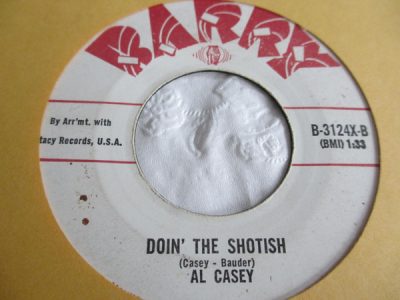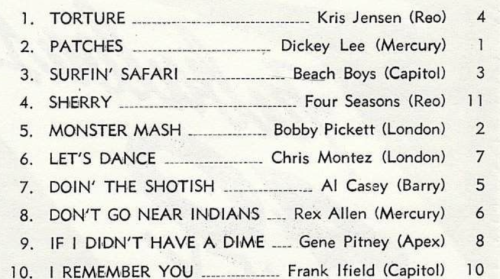#66: Doin’ The Shotfish by Al Casey
City: Edmonton, AB
Radio Station: CJCA
Peak Month: October 1962
Peak Position in Edmonton: #5
Peak position in Vancouver ~ did not chart
Peak Position on Billboard Hot 100 ~ did not chart
YouTube: “Doin’ The Shotfish”
Alvin Wayne Casey was born in Long Beach, California, and moved to Phoenix, Arizona, when he was two years old. His father played the guitar and tried to teach six-year-old Casey to play. But when his father realized young Alvins fingers were too small, he gave him a ukulele instead. At the age of eight, Al Casey switched to the steel guitar and began taking formal music lessons. By the time he was 14, he was playing the steel guitar for various clubs in Phoenix. In his later teens he performed five to six nights a week. When Al Casey was 20 he became serious about playing a traditional guitar.
In his teens, Al Casey joined a local group, the Sunset Riders, and worked with vocalist Jody Reynolds. Around 1956, Casey crossed paths with Lee Hazelwood, a Coolidge, Arizona, radio DJ who was looking for a singer to record his song, “The Fool”. Casey suggested his schoolmate and friend Sanford Clark for the lead vocals. Casey played guitar for the recording and suggested a guitar riff which he had taken from Howlin’ Wolf’s song “Smokestack Lightnin”. “The Fool” became a national hit and reached number No. 9 on the Billboard Top 10 pop charts. It also put the Phoenix music scene in the national spotlight. Due to the song’s success, Casey went on a week long rockabilly tour with Carl Perkins, Gene Vincent, Eddie Cochran, Johnny Burnette, and Sonny James, traveling the country in Sanford Clark’s Ford Mercury.
In 1955, Casey met Duane Eddy and joined his band, Duane Eddy and the Rebels. For five years, Casey worked on and off with Eddy’s band and performed for the Alan Freed and Dick Clark shows. Casey was also part of the backup for other Eddy recordings, playing bass, piano, and rhythm guitar. Casey wrote one of Eddy’s earliest hits, “Ramrod” in 1958. When Eddy performed the song on American Bandstand, he was flooded with requests for the single. “Ramrod” peaked at #27 on the Billboard Hot 100 and #17 on the Billboard R&B charts in 1958. Casey also co-wrote another Eddy hit, “Forty Miles of Bad Road”, which peaked at #9 on Billboard‘s Hot 100 in July 1959. In 1958, Al Casey also played guitar on Jody Reynolds’s #5 hit song in the USA, “Endless Sleep”. The song peaked at #1 in London (ON), #2 in Toronto, #3 in Guelph (ON), #4 in Vancouver (BC), and Dauphin (MB).
In early 1958, Al Casey had a minor hit with “Willa Mae” in Gary (IN). He cowrote it with Lee Hazelwood. The singer confessed:
You give me chills when we meet.
Like a bulldog walkin’ barefoot on a cold-cold street.
Willa Mae, a-come a-shakin’ by my way
You got the love I need, honey yes indeed.
Oh Willa Mae.
” A year later, Casey made the Top 40 in Phoenix with his instrumental “The Stinger”. It was also a joint composition between Al Casey and Lee Hazelwood.
The Al Casey Combo released a single in 1961 titled “Hotfoot”. It made the playlist in Chicago that summer. In early 1962, Casey released “Cookin'”. The instrumental climbed to #9 in Rockville (MD), #13 in Seattle and Chicago, and #14 in Dayton (OH). It was also a Top 30 hit in Denver, San Francisco and Fargo (ND).
The A-side of the release was “Jivin’ Around”. It was a Top 30 hit in Toronto, a Top 20 hit in Chicago, and climbed to #11 in Detroit. But it was the B-side, “Doin’ The Shotfish”, which got airplay in Edmonton.

“Doin’ The Shotfish” was written by Al Casey and saxophonist Brad Bauder. The track has an instrumental surfin’ vibe to it. Six years later, Brad Bauder was in the recording studio with Friends of Distinction. He played saxophone and clarinet on their hits 1969 “Grazing In The Grass” and “Going In Circles”. Over the years, Bauder cowrote a half dozen songs for Al Casey that he also played in the recording studio.
Edmonton seems to have been the only radio market in Canada or the USA to chart “Doin’ The Shotfish”, peaking at #5.
In March 1963, Al Casey had a Top 50 hit in Vancouver with the instrumental “Doin’ It”. The single reached #13 in Buffalo. He added a backing female vocal chorus on “What Are We Gonna Do In ’64?” named the K-C-ettes. The single was a Top 40 hit in Minneapolis/St. Paul in early ’64. But it was blown away by Beatlemania. The song asked “What we gonna do in ’64? What’s there to do? Will it be something strange and new? Will it be something for the blues? I don’t care as long as I’m with you in 1964.” But by mid-January 1964, the Beatles’ were already on top of the pop charts with “I Want To Hold Your Hand” and “She Loves You”. The strange and new Beatles with their ‘mop top’ Beatle haircuts, and screaming fans answered the question posed in Al Casey’s song.
In 1964, he gave up touring and began to play a variety of music styles for studio sessions. In 1965, Casey moved to Los Angeles and became part of the group of session musicians which became known as the Wrecking Crew. He worked with this group for 18 years playing a variety of music styles including jazz, country, rock, and pop. As a member of the Wrecking Crew, he worked for artists that include the Beach Boys, Elvis Presley, Glen Campbell including on “Galveston”, “Where’s The Playground Susie”, “Try A Little Tenderness”, and “Wichita Lineman”, the Association, the Monkees on “Daydream Believer”; Johnny Cash, Eddy Arnold, Simon & Garfunkel, the Fifth Dimension on “Up, Up And Away”, “Working On A Groovy Thing”, “Carpet Man”, Harry Nilsson, Bobby Darin on “If I Were A Carpenter”; Delaney & Bonnie, the Partridge Family, Frank Sinatra including “Strangers In The Night”; Nancy Sinatra on “Sugar Town”; Mason Williams on “Classical Gas”; Neil Diamond on “Cracklin’ Rosie”, “Done Too Soon”, “Soolaimon”, and “He Ain’t Heavy, He’s My Brother”; the Hues Corporation, Anne Murray, and others. He also worked with Phil Spector in the recording studio with many of Spector’s recording acts. During this time, Casey also worked for three years as a member of the band on The Dean Martin Show.
In the late 1960s, Casey owned a music store in Hollywood called Al Casey’s Music Room.
On August 3, 1967, George Harrison went with Neil Aspinall to Western recorders studio to gate crash a session with Lou Adler and John Philips. Mike Deasy, one of the session players, was playing a prototype Bartell Fretless Guitar that Harrison was very interested in. Aspinall immediately ordered one of the new ‘Secret’ guitars from Al Casey. It was Casey’s wife Maxine who delivered the Bartell to Harrison on Blue Jay Way. A couple of weeks later Casey took out an advertisement in the Los Angeles Free Press saying, “George Harrison got the first guitar, maybe if you hurry you can get the second one!” The Bartell became one of the rarest Beatles guitars and was played by both John Lennon and George Harrison on The Beatles’ White Album –— it sold in 2020 for $300,000.
In 1968, Casey loaned his red Hagstrom Viking II guitar to Elvis Presley for his ’68 Comeback Special.
In 1983, Casey moved back to Phoenix where he taught guitar lessons at Ziggie’s Music and performed for occasional shows. He died in 2006 at the age of 69. In 2008, Al Casey was one of the musicians featured in the documentary The Wrecking Crew. He has been inducted into the Rockabilly Hall of Fame and the Arizona Music Hall of Fame.
October 5, 2024
Ray McGinnis
References:
“Al Casey – Obituary,” Arizona Republic, Phoenix, AZ, September 20, 2006.
***
This Week Last Week

CJCA 930-AM, Edmonton (AB) Top Ten | October 7, 1962

Leave a Reply